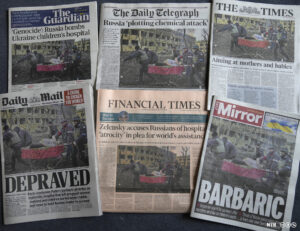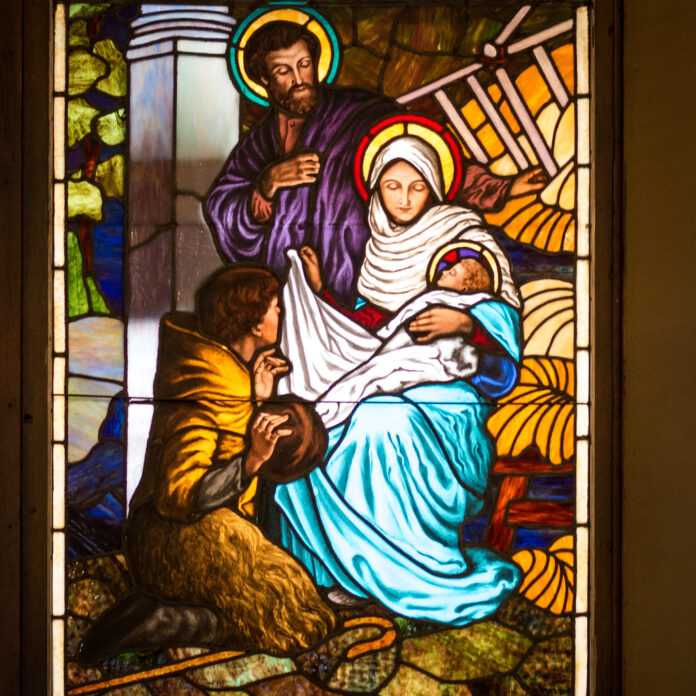
‘The image sticks in the mind. A young woman, her heavily pregnant belly heaving, as she is carried on a stretcher away from a blasted-out building’.[1] These words almost say it all. Tragically they refer to the picture on the cover page of The Sunday Times magazine portraying 2022/The Year in Pictures, taken outside Maternity Hospital No. 3 in Mariupol, Ukraine, on March 9th of that year after an air strike on the facility. Sadly, the woman was fatally wounded and ‘the baby was stillborn: a little boy that his parents [Iryna and Ivan] had planned to call Miron after the Russian word for peace’.[2] The pathos of this picture is all the more profound when viewed in the panorama of photographs and clips of civilians caught up in the violence of present and pitiless conflicts. While the church celebrates in joy and gladness the journey of Mary and Joseph to Bethlehem and the birth of Jesus, the cross of suffering, separation and sadness in our ‘death-shadowed world’[3] is never far from its consciousness.
Word made flesh
The two great mysteries of Christ’s life are the Incarnation and the Resurrection. Christmas puts the focus on the child in the crib while Easter emphasizes the empty tomb and the subsequent appearances of the Risen Lord to the disciples. While we are more familiar with the so-called Infancy Narratives in the Gospels of Matthew and Luke, it is in the Gospel of John that we hear the crescendo in the Prologue (read at Mass on Christmas Day), ‘The Word became flesh and lived among us’. Here the evangelist emphasises the entry of the eternal Word on earth, the human existence of ‘the only-begotten Son of the Father’. The church eschews any element of excarnation as emphasized by Pope Francis in his exclusion of any trace of Gnosticism from Christian faith, a heresy which exclaims salvation through escape from any form of earthly existence. While retaining the romantic, the Christmas story is rooted in a realism which recognizes both the fragility of life and the fortitude needed to face it. Christmas does not communicate or contemplate an abstract truth; the crib is not a computer containing a program but a manger nestling a newborn baby. A poor imitation of a Moses Basket, the manger symbolizes the messy human situation in which the heavenly Son of God is immersed and identifies with, ‘for us and for our salvation’. While God-in-man remains mystery, the mission of the Word made flesh is to make us friends and family of the heavenly Father.
Christmas is not a fairytale but a festival in which the church celebrates its three ‘R’s: remembering in faith the coming of the Messiah, the Christ child; renewing its hope in the coming of the Lord in majesty; receiving by charity the coming of God’s grace in mystery.
‘The maiden is with child’
Heard throughout Advent this proclamation from the prophet Isaiah continues ‘and shall bear a son and shall name him Immanuel’ (7:14). Taken over into the Gospel of Matthew and translated ‘the virgin shall conceive’, the evangelist explains the name Immanuel ‘which means “God is with us” (1:23), an indication of the Virgin birth of Jesus following his conception by Mary through the Holy Spirit. Mary is, of course, central to the Christmas story as mother of the child in the crib, the Christ. Her consent – complete and continual – to the invitation of the angel to be intimately involved in the Incarnation is now carried out in childbirth and care for the infant in her arms, an image that has been the inspiration for artists throughout the centuries which appear on many religious Christmas cards.
Prince of Peace
Widespread wars in the world today may make people wary of talk about peace. A world-weary cynicism might conclude that there is no point in talking, even thinking, about peace. However, this is to give up on the moral virtues of justice and courage and fail to hang onto the theological virtue of hope. As with the conception of Jesus an angel announces the advent of peace associated with his birth: ‘And this is a sign for you: you will find a baby wrapped in swaddling clothes and lying in a manger. And suddenly there was with the angel a throng of the heavenly host, praising God and saying: ‘Glory to God in the highest heaven, and on earth peace among people of good will.’ (Lk 2:13-14). While, in the words of Joseph Ratzinger (Pope Benedict XVI), ‘God is glorious, is indestructible truth, eternal beauty [and] that is the fundamental, comforting security of our faith’[4], God may still be glorified on earth by peaceful living among peoples. This year is the 55th anniversary of the meeting of the Bishops of Latin America after the Second Vatican Council at Medellίn and the Conference document characterized the ‘Christian view of peace’ as formed by the following three factors: ‘a work of justice [which] presupposes and requires the establishment of a just order; ‘a permanent task [because] peace is not found, it is built; the fruit of love [which] is the expression of true fraternity, given by Christ, Prince of Peace, in reconciling all people with the Father’. The declaration – ‘Peace with God is the basic foundation of internal and social peace’[5] – invites the three ‘Ds’ of devotion, discernment and doing on our part as we honour the presence of the Prince of Peace in our hearts and homes this Christmas.
As Mother of the Prince of Peace we can ask Mary to intercede: Our Lady, Queen of peace, pray for us.
Fr Kevin O’Gorman, SMA
[1] Naomi O’Leary, ‘Europe Letter’, The Irish Times, 16th November 2023.
[2] Idem.
[3] Phrase taken from Michael Simone, America, 216 (3rd April 2017), 52.
[4] Jesus of Nazareth – The Infancy Narratives, p. 76
[5] From eds. David J. O’Brien and Thomas A. Shannon, ‘Medellín Conference’ in Renewing the Earth – Catholic Documents on Peace, Justice and Liberation, (Image Books).


You must be logged in to post a comment.